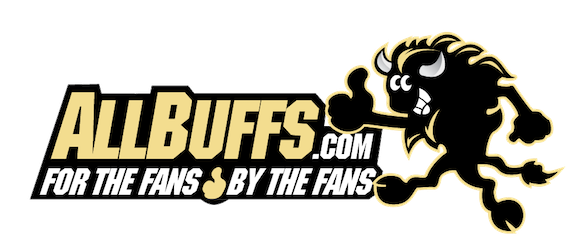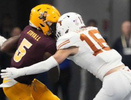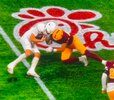You and I played football in the same era. I was taught to keep my head up and drive into the center of the body of the ball carrier, not to drive my head into theirs (though that would not have been a penalty at that time).True. I think what I struggle with is that the way I was taught to tackle was to lead with my nose and then roll my hips to drive through the ball carrier. I realize I'm a dinosaur and rules have changed to reduce head injuries, but often times when I see something called targeting my reaction is that it was a form tackle and that's just football.
-
Prime Time. Prime Time. Its a new era for Colorado football. Consider signing up for a club membership! For $20/year, you can get access to all the special features at Allbuffs, including club member only forums, dark mode, avatars and best of all no ads ! But seriously, please sign up so that we can pay the bills. No one earns money here, and we can use your $20 to keep this hellhole running. You can sign up for a club membership by navigating to your account in the upper right and clicking on "Account Upgrades". Make it happen!
You are using an out of date browser. It may not display this or other websites correctly.
You should upgrade or use an alternative browser.
You should upgrade or use an alternative browser.
Targeting
- Thread starter Buffarino
- Start date
For sure. But a facemask to the sternum or shoulder and driving through often results in the contact sliding to the head if you don't completely blow the dude up on initial contact. Also, ball carriers often approach a tackler with a "low man wins" approach and present their head as the target instead of giving up their core. I absolutely agree that actual head hunting was always a dirty play, but I think the way it's called goes way beyond that. Unfortunately, I think it's impossible to put these types of judgment calls on refs and expect them to get it right (the reason they got rid of the 5-yard facemasking call). I acknowledge you guys are right. Just saying it doesn't feel right to me at times and I don't have a good handle on what the review booth is going to rule on a targeting review.You and I played football in the same era. I was taught to keep my head up and drive into the center of the body of the ball carrier, not to drive my head into theirs (though that would not have been a penalty at that time).
Did you watch the video? He ran at the ASU receiver, in his most vulnerable moment, and hit his head with his own at full speed. I'm not sure what you're asking. I don't know how he could have hit him harder, so I'm unsure what clarification you're seeking regarding "drove".
Not flaming - just confused on the distinction that you're seeking here.
Simmons, arguably ASU's best defender was ejected for hitting Brecht in the face with the exact same part of his helmet, and missed the first half of the Texas game.
Both players were running at full speed and hit defenseless players (I'd argue the ASU receiver was more defenseless than Brecht, but whatever) in the face.
Maybe you can explain the difference to me.
15 years ago, we all applaud this as a great downhill, form fit tackle. The shear speed of it, not necessarily the final contact is what made it worse. As a coach, the only thing you can possibly coach in response to this call is to go lower, but you risk missing the tackle all together and/or getting called for going for the knees. You can't win.
And now they're starting to ban the "wrap the legs and roll, letting gravity help make the tackle" - so-called rugby style tackling. It was supposed to be safer and it is for head injuries. But hip drop tackles are causing significant leg injuries to ball carriers. I honestly don't know what I'd teach if I was coaching defense these days.15 years ago, we all applaud this as a great downhill, form fit tackle. The shear speed of it, not necessarily the final contact is what made it worse. As a coach, the only thing you can possibly coach in response to this call is to go lower, but you risk missing the tackle all together and/or getting called for going for the knees. You can't win.
Which one? Simmons or Taaffe?15 years ago, we all applaud this as a great downhill, form fit tackle. The shear speed of it, not necessarily the final contact is what made it worse. As a coach, the only thing you can possibly coach in response to this call is to go lower, but you risk missing the tackle all together and/or getting called for going for the knees. You can't win.
Look, I get that it's a violent sport, and these plays happen bang bang. But this is an elite athlete watching the play unfold in front of him. He had plenty of opportunity to not do this:
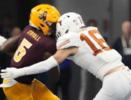
I think a bunch of targeting calls are bull****.For sure. But a facemask to the sternum or shoulder and driving through often results in the contact sliding to the head if you don't completely blow the dude up on initial contact. Also, ball carriers often approach a tackler with a "low man wins" approach and present their head as the target instead of giving up their core. I absolutely agree that actual head hunting was always a dirty play, but I think the way it's called goes way beyond that. Unfortunately, I think it's impossible to put these types of judgment calls on refs and expect them to get it right (the reason they got rid of the 5-yard facemasking call). I acknowledge you guys are right. Just saying it doesn't feel right to me at times and I don't have a good handle on what the review booth is going to rule on a targeting review.
But I think this hit by Taaffe didn't just fall into a technicality. I think it was text book targeting, and exactly what the rule was designed to prohibit. I mean, he knocked the receiver unconscious as far as I can tell.
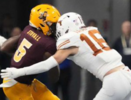
Last edited:
BuffWarHogFrog
Just be rad
Did you watch the video? He ran at the ASU receiver, in his most vulnerable moment, and hit his head with his own at full speed. I'm not sure what you're asking. I don't know how he could have hit him harder, so I'm unsure what clarification you're seeking regarding "drove".
Not flaming - just confused on the distinction that you're seeking here.
Simmons, arguably ASU's best defender was ejected for hitting Brecht in the face with the exact same part of his helmet, and missed the first half of the Texas game.
Both players were running at full speed and hit defenseless players (I'd argue the ASU receiver was more defenseless than Brecht, but whatever) in the face.
Maybe you can explain the difference to me.
Technically he met an indicator (2 actually) - crouched and dove. Taffe didn’t meet that.
I’d also argue that Taffe’s arms are wrapped here.
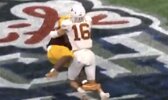
His arms didn’t touch until after the helmet contact. Have you watched the video at all?Technically he met an indicator (2 actually) - crouched and dove. Taffe didn’t meet that.
I’d also argue that Taffe’s arms are wrapped here.
View attachment 80360
as I understand it the indicators are “and/or.”. Only ONE indicator needs to be met.
He clearly met this one:
Last edited:
BuffWarHogFrog
Just be rad
I know his arms didn’t touch until after the tackle, but that’s a normal tackle. You can’t tackle someone if the first thing to touch is your arm. Paging Dr Shilo.His arms didn’t touch until after the helmet contact. Have you watched the video at all?
as I understand it the indicators are “and/or.”. Only ONE indicator needs to be met.
He clearly met this one:
View attachment 80361
As for leading with the head, from what I’ve tethered from watching almost every play of every game that been on tv, that means that you either have your arm tucked, or they are in no athletic position to make a tackle. That’s why I don’t think Taffe’s was targeting.
(Also, I’ve now watched this play probably close to infinity times). (And also, hopefully I’ll be leaving Texas by Sep).
If you've watched that play close to infinity times and can't see that the defender led with his helmet to attack with forcible contact at the head or neck area then you're probably an NFO. I don't know what else to say at this point.I know his arms didn’t touch until after the tackle, but that’s a normal tackle. You can’t tackle someone if the first thing to touch is your arm. Paging Dr Shilo.
As for leading with the head, from what I’ve tethered from watching almost every play of every game that been on tv, that means that you either have your arm tucked, or they are in no athletic position to make a tackle. That’s why I don’t think Taffe’s was targeting.
(Also, I’ve now watched this play probably close to infinity times). (And also, hopefully I’ll be leaving Texas by Sep).
The ASU player was defenseless by definition and the defender led with his helmet to create forcible contact to the receiver's head. It's not really a debatable thing. It was textbook targeting.
When defenders find themselves in that position with that kind of closure and angle, they often throw an arm to the torso to avoid the helmet contact. Taaffe has sufficient athleticism to have avoided that hit; you can't convince me otherwise. And since I can't convince you, there's probably no point in continuing this conversation.
But remember, you're seeing things the way that Hawg1 does. Let that sink in.
I thought they would for sure call targeting when the play happened, and was pleasantly surprised that they didn’t (agree this would have been called targeting in many games).
Taffe did everything right on the play. Broke on the ball hard when it was thrown, and was a step or two away when the receiver caught the ball, which is when you see Taffe immediately get into an appropriate tackling posture. Receiver turns into him and they both hit heads. If I had to guess, the replay booth would rely on the “drove” part of the rule not being fulfilled, because he was already in position to complete the play in the way he did (with good sound technique, and did NOT launch into his head instead and/or use the crown of his helmet). I also believe in the context of the play, and how it happened, the replay booth probably took issue with being a determiner of the game in such a key moment on a bang bang play…just a guess.
I agree this seems inconsistent with how it’s called a lot of the time, but frankly I think the penalty gets called incorrectly against the defender far too often IMO (i.e. not within my understanding of the intent of the rule).
Taffe did everything right on the play. Broke on the ball hard when it was thrown, and was a step or two away when the receiver caught the ball, which is when you see Taffe immediately get into an appropriate tackling posture. Receiver turns into him and they both hit heads. If I had to guess, the replay booth would rely on the “drove” part of the rule not being fulfilled, because he was already in position to complete the play in the way he did (with good sound technique, and did NOT launch into his head instead and/or use the crown of his helmet). I also believe in the context of the play, and how it happened, the replay booth probably took issue with being a determiner of the game in such a key moment on a bang bang play…just a guess.
I agree this seems inconsistent with how it’s called a lot of the time, but frankly I think the penalty gets called incorrectly against the defender far too often IMO (i.e. not within my understanding of the intent of the rule).
I think where I'm at is that it's either a penalty in every game regardless of time or score, or it's never a penalty.
I could get behind the hit the Texas player made never being a penalty.
But that's not where we are. That's a called penalty in 80-90% of the games I've watched the last couple years, and consequently yes, I think it's bullshît that it was not in this one.
I could get behind the hit the Texas player made never being a penalty.
But that's not where we are. That's a called penalty in 80-90% of the games I've watched the last couple years, and consequently yes, I think it's bullshît that it was not in this one.
Then only answer to get rid of targeting or change the game of football as we know it. I don’t disagree with your assessment, but in the name of safety they have instituted a subjective set of parameters in the name of safety (and to limit liability), while simultaneously trying to preserve the game in its current form. This conflict inherently allows for the call to be made more like a defensive foul in basketball, and I agree that sucks.I think where I'm at is that it's either a penalty in every game regardless of time or score, or it's never a penalty.
I could get behind the hit the Texas player made never being a penalty.
But that's not where we are. That's a called penalty in 80-90% of the games I've watched the last couple years, and consequently yes, I think it's bullshît that it was not in this one.
Especially when ASU was already missing a player for forcibly hitting a defenseless player in the head.I think where I'm at is that it's either a penalty in every game regardless of time or score, or it's never a penalty.
I could get behind the hit the Texas player made never being a penalty.
But that's not where we are. That's a called penalty in 80-90% of the games I've watched the last couple years, and consequently yes, I think it's bullshît that it was not in this one.
Imagine how frustrating to lose a player for it, but not get the call when it happens to your player.
Agree. But somehow I think the replay officials are more forgiving when the face is up.thats my point.Maybe, but I'm not convinced there's any conventional understanding of a person's 'head' that doesn't consider their face as a part of it.
Last edited:
Did you watch the video? He ran at the ASU receiver, in his most vulnerable moment, and hit his head with his own at full speed. I'm not sure what you're asking. I don't know how he could have hit him harder, so I'm unsure what clarification you're seeking regarding "drove".
Not flaming - just confused on the distinction that you're seeking here.
Simmons, arguably ASU's best defender was ejected for hitting Brecht in the face with the exact same part of his helmet, and missed the first half of the Texas game.
Both players were running at full speed and hit defenseless players (I'd argue the ASU receiver was more defenseless than Brecht, but whatever) in the face.
Maybe you can explain the difference to me.
Drove is not in the definition for a defenseless player, is it? Maybe I missed it. But That’s my point. Attack is.
Did he attack? I don’t think he did. I think he made a tackle in a snap moment with his face up.
Last edited:
Yes. That’s face.
What do you think "attack" means in this context?Drove is not in the definition for a defenseless player, is it? Maybe I missed it. But That’s my point. Attack is.
Did he attack? I don’t think he did. I think he made a tackle in a snap moment with his face up.
Do you think he could have done anything to impact him in the head harder?
Closing speed was tremendous, I acknowledge. But these are elite athletes with uncanny body control who know the game. Taaffe knew ten steps out exactly how and where he was going to impact Stovall.
Violence is part of the game that we all love. But using your helmet (or forearm, or hand, or shoulder) to hit another player in the head is targeting. That's the rule, and it gets enforced all of the time. Using "well...I'm not sure it satisfied the condition of an attack" is a bizarre semantic deflection. He literally hit him in the head with his helmet as hard as he possibly could. Do you think that an "attack" requires like a hammer or something?
What do you think "attack" means in this context?
Do you think he could have done anything to impact him in the head harder?
Closing speed was tremendous, I acknowledge. But these are elite athletes with uncanny body control who know the game. Taaffe knew ten steps out exactly how and where he was going to impact Stovall.
Violence is part of the game that we all love. But using your helmet (or forearm, or hand, or shoulder) to hit another player in the head is targeting. That's the rule, and it gets enforced all of the time. Using "well...I'm not sure it satisfied the condition of an attack" is a bizarre semantic deflection. He literally hit him in the head with his helmet as hard as he possibly could. Do you think that an "attack" requires like a hammer or something?
Now we have to worry about defenders carrying hammers?
Bears can smell menstruation.Now we have to worry about defenders carrying hammers?
What do you think "attack" means in this context?
Do you think he could have done anything to impact him in the head harder?
Closing speed was tremendous, I acknowledge. But these are elite athletes with uncanny body control who know the game. Taaffe knew ten steps out exactly how and where he was going to impact Stovall.
Violence is part of the game that we all love. But using your helmet (or forearm, or hand, or shoulder) to hit another player in the head is targeting. That's the rule, and it gets enforced all of the time. Using "well...I'm not sure it satisfied the condition of an attack" is a bizarre semantic deflection. He literally hit him in the head with his helmet as hard as he possibly could. Do you think that an "attack" requires like a hammer or something?
There a whole body of thought around intention andmany think the rule progresses that way, especially Klatt. One involves a suspension. One doesn’t. It’s a whole can of worms IMO.
Some read the rule that way now when they interpret attack. Was a bang/bang football play made where the head was involved and the face was up?
I can see how a non-call was made in this instance, although I thought it was targeting when the play happened
I don’t think he attacked. You do, including drove. That’s cool.
Either way, I hate it likely affected the outcome of the game.
I suspect the word "attack" was included to give an out for those players that were clearly trying to avoid contact to the head, change trajectory, lessen the blow or slow down when faced with imminent impact.There a whole body of thought around intention andmany think the rule progresses that way, especially Klatt. One involves a suspension. One doesn’t. It’s a whole can of worms IMO.
Some read the rule that way now when they interpret attack. Was a bang/bang football play made where the head was involved and the face was up?
I can see how a non-call was made in this instance, although I thought it was targeting when the play happened
I don’t think he attacked. You do, including drove. That’s cool.
Either way, I hate it likely affected the outcome of the game.
In this case, none of those things happened. There is nothing Taaffe could have done to hit the defenseless receiver harder in the head, with his own head, than what he did. Therefore, I'm not sure how some semantic review of the inclusion of the word "attack" is even relevant.
I suspect the word "attack" was included to give an out for those players that were clearly trying to avoid contact to the head, change trajectory, lessen the blow or slow down when faced with imminent impact.
In this case, none of those things happened. There is nothing Taaffe could have done to hit the defenseless receiver harder in the head, with his own head, than what he did. Therefore, I'm not sure how some semantic review of the inclusion of the word "attack" is even relevant.
Yep. I see you don’t see it. That’s cool. Others do/did.
I wish we had a pool report from the replay officials.
Yes, I'm sorry that I'm slow to recognize things and struggle to understand the word "attack" in this context. I appreciate your patience with me.Yep. I see you don’t see it. That’s cool. Others do/did.
I wish we had a pool report from the replay officials.
BuffWarHogFrog
Just be rad
All the time - it's a big part of the game.Helmet to helmet happens
View attachment 80382
It's the defenseless players that the rules are designed to protect.
I'm not sure of the context of your photo. Is the ball carrier in your photo...
